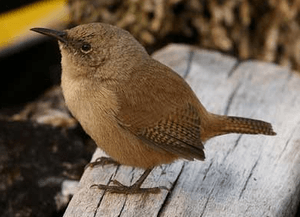Cobb's wren facts for kids
Quick facts for kids Cobb's wren |
|
|---|---|
 |
|
| Conservation status | |
| Scientific classification | |
| Genus: |
Troglodytes
|
| Species: |
cobbi
|
The Cobb's wren (Troglodytes cobbi) is a small bird, about 12 to 13.5 centimeters long. It is a type of wren found only on the Falkland Islands. This means it is endemic to these islands.
Scientists used to think it was a type of house wren. But now, they agree it's its own species. This is because it has different feathers, sounds, habits, and body shapes. The bird's common and scientific names honor Arthur Cobb. He was an author from the Falkland Islands.
Contents
What Does Cobb's Wren Look Like?
Cobb's wrens have brown feathers. Their head and chest are a bit grayer. Their tail has more of a reddish-brown color. You can see dark stripes on their wing feathers and tail. Their beak is long, blackish, and slightly curved.
It can sometimes be confused with the sedge wren. But the sedge wren is smaller. It also has a shorter beak. The sedge wren has a light stripe above its eye. It also has dark streaks on its back and head.
Cobb's wrens make many buzzing sounds. Their song is a mix of trills and whistles. You can hear them sing from August to February. Each male wren has its own unique song pattern.
How Does Cobb's Wren Live?
These birds usually live near the coast. They like areas with thick tussac grass. You can often find them on beaches. They search among kelp and other things washed ashore. They look for small bugs like insects and amphipods to eat.
Cobb's wrens are quite tame. You can often get close to them. If they feel bothered, they don't usually fly away. Instead, they prefer to sneak away. They move like a mouse between rocks or clumps of grass.
Building Nests and Raising Young
The nest of a Cobb's wren is shaped like a ball. It is made of grass. Inside, it is lined with feathers and fibers from tussac grass roots. They build their nests on or near the ground. Nests are often hidden among tussac grass or in cracks in rocks.
The eggs are a pinkish color. They have small reddish spots. A female usually lays three or four eggs at a time. Eggs are laid from early October to December. It is likely that they raise two groups of young during the breeding season.
Protecting Cobb's Wren
This wren only lives on small islands that do not have rats. In 1997 and 1998, there were only about 4,500 to 8,000 pairs. Their populations are spread out in small groups. These groups could disappear if rats or cats arrive on their islands.
Cobb's wrens feed and nest on the ground. This makes them very easy targets for predators. Other birds, like the sedge wren, live higher up. They can live alongside predators more easily.
The challenges faced by Cobb's wren became more widely known. It was featured as an endangered species in National Geographic Magazine in February 2009.
In 2017, the IUCN changed its status. It is now listed as a least concern species. This is thanks to efforts to control invasive rats on nearby islands.
See also
 In Spanish: Chochín malvinero para niños
In Spanish: Chochín malvinero para niños


